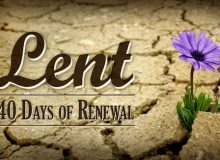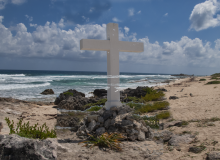Advent was not always understood as a countdown to Christmas. In fact, the origins of our modern-day Advent celebration may not have had much to do with December 25th at all. What is Advent? As the days shorten and the nights grow colder, Christians embrace God’s promise of light. Heralding the beginning of the church calendar year, Advent begins on the Sunday between November 27th and December 3rd. [1] Deriving from the Latin word, adventus, the word means “coming,” “approach,” or “arrival.” “Advent” is also a translation of the Greek παρουσία (parousia), a word historically used in the church to signify Christ’s second coming. The church collectively waits with hope-filled anticipation for arrival, “Advent,” of Christ in our world, the One born in the flesh and whose presence is with us both now and eternally. What is the history of the Advent wreath? Protestants, Roman Catholics, Orthodox, and other Christian traditions around the world celebrate the season of Advent with a host of annual rituals: contemplative worship, prayer, scripture study, and daily devotionals to name a few. In Journey into the Heart of God: Living the Liturgical Year, Philip Pfatteicher lifts up an enduring appeal of the Advent season: the development of meaningful traditions and customs celebrated both in worship, as well as in the home with our families. Today, the Advent wreath is one of most common symbols associated with the season. Invented by Johann Hinrich Wichern in 1839, the Advent wreath was intended as a physical sign to help bring the spirit and expectation of the season to young boys living in a settlement house that Wichern founded in Hamburg. Evergreens and fire, two of the main materials that make up the Advent wreath, are both deeply rooted in ancient, pre-Christian symbolism associated with everlasting life. Though traditions vary today, four candles typically form a circle around the outside with one white candle in the middle, known as the Christ Candle. The four outer candles customarily represent peace, hope, joy, and love. One candle is lit for each of the four Sundays of Advent, with the Christ Candle as the final one we light on Christmas Eve. Why do churches decorate with purple during Advent? Rich, deep colors are symbolic of the Advent season. As in the season of Lent, purple is one of the main liturgical hues associated with Advent. Philip Pfatteicher observes that the color purple holds different meanings for different church calendar seasons. Purple represents penitence during the Lenten season. Whereas during Advent, purple is often associated with royalty, signifying the anticipated arrival of Christ the king. Dark blue is also commonly recognized during Advent. In church history, a deep shade of blue is symbolic of hope and also of Mary, the mother of Jesus. Today, throughout the Advent season, clergy wear purple or dark blue vestments and churches are adorned in purple or dark blue paraments. In the Middle Ages, black was also a liturgical color associated with the observance of Advent. |
What are the historical origins of Advent?
Much like the mystical spirit of the season, the precise historical origins of Advent are something of a mystery. Scholars have pieced together significant evidence for annual liturgical periods of fasting and preparation in the early Christian church. Notably, these early Advent seasons didn’t culminate on December 25th but instead on January 6th, the day of Epiphany. On Epiphany, the church commemorates the revelation of the Christ-child to the world, represented by the three magi who traveled a great distance to Bethlehem to pay him homage. The early church’s observance of Epiphany included themes of the nativity, Jesus’ baptism, the miracle of the Jesus’ turning of the water into wine at Cana, and other revelations of Jesus’ identity to the world. In the West, Epiphany was marked as a feast day for the baptism and joyful reception of new catechumens, or converts, into the life of the church. In The Origins of Feasts, Fasts, and Seasons in Early Christianity, Bradshaw and Johnson point out that the connection between Epiphany and Jesus’ baptism is stronger in the Eastern church than in the West. In the Western Church, Jesus’ baptism would later come to be celebrated on a Sunday after the Sunday of Epiphany, as it is today. Scholars believe that our modern-day Advent observance may have its origins in Spain and in Gaul. In the sixth century, the church in Rome observes a similar season of preparation for baptism. Bradshaw and Johnson note that these early church preparatory observances were of varying lengths, anywhere from three weeks to a six-week Advent in Rome. Pope Gregory I at the end of the sixth century eventually shortens the length of the Advent season to four weeks. Christmas Day, commemorated on December 25th, began as a local Roman church observance. In Rome, the four Sundays of Advent leading up to Christmas were officially set by Pope Gregory I. Though the early church’s celebration of Epiphany on January 6th was much older and celebrated more broadly, as Christmas Day gained wider acceptance in the church, the celebration of Advent became oriented not toward preparation for Epiphany but for Christmas. What is the theological significance of Advent? As early church Advent celebrations were not centered upon December 25th at all, theologically Advent is oriented beyond the birthday of Jesus. Advent prepares us to celebrate Jesus Christ’s arrival, born into our broken world as a real, en-fleshed human being. However, the season of Advent also directs us toward the ultimate, eschatological hope of our eternal Savior’s second coming and the subsequent reconciliation of all things. In other words, we spiritually “get ready” for Christ to come again. In Journey into the Heart of God: Living the Liturgical Year, Philip Pfatteicher writes, “The spirit of the season is expressed in the impatient cry of a sometimes desperate people, ‘O that you would tear open the heavens and come down’ (Isaiah 64:1).” In contrast to the often-ostentatious ethos of the commercial Christmas season, the Church’s Advent is a somber and soulful time of contemplation. Many of our Advent scriptures and hymns are of lament. A very familiar Advent hymn, “O Come, O Come Emmanuel,” has a haunting minor melody, in which the chorus cries out for God to save God’s people, to “ransom captive Israel.” In the final days of Advent, many churches hold “Longest Night” worship services in the evening, intentional spaces for communities to gather and lay bare the sadness and grief so often felt on these longest nights of the year. The Church’s Advent journey does not abandon us at the threshold of despair and sorrow. Ultimately, this season orients us toward hope in a Savior who has the power to break through the anguish and sins of this world—and to ultimately redeem us all. The theme of the fourth and final Sunday in Advent is profoundly Incarnational, pointing us toward the eternal hope of God’s people in Jesus Christ and the enduring promise that our prayers for salvation have at last been answered. The Catholic Church has recited morning prayers together for hundreds and hundreds of years. One line of praise from these morning prayers (Lauds) on the final days of Advent strikes a triumphant and optimistic tone, beautifully summing up our ultimate hope of the Advent season: “The Lord is here; go out to meet him, saying: Great is his birth, eternal his kingdom, strong God, Ruler of all, Prince of peace, alleluia!”
|








